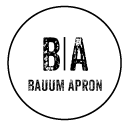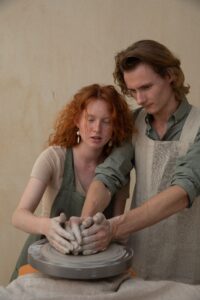Trusted Apron Complete History

Starting from the very word apron origin,
It seems that today popular apron came from the middle English word naperon, which comes from Old French word nape/nappe (which meant tablecloth) which come from the Latin word mappa ( which meant napkin). So easily we can see that the word apron a relative of the napkin and tablecloth. The apron had different uses across the time: decorative / fashion, symbolic / ceremonial, protective.
Aprons were used since ancient times
Figurines of goddesses wearing aprons were found on the Crete Island, in Greece and they have been dated to be from 1600 B.C. In ancient Egypt were found wall paintings of gods wearing a triangular apron. Artifacts from China and Central America show Gods wearing various types of aprons. Priests were wearing aprons as a sign of “being chosen” by the God and sign of their authority. During the Industrial Revolution, aprons were very popular, and they were part of the uniform for in factories.
In Europe in Middle Ages, the apron was worn by a variety of people, tradesmen, housewives, blacksmiths, artisans, weapon and armour makers, fishmongers, furniture makers, masons and others with the purpose to protect their clothing and their flesh. A different colour of the apron was indicating the profession, that the person was in, although it wasn’t a rule: checkered apron for barbers, white apron for stonemasons, black apron for cobblers, blue striped apron for butchers, green apron for butlers, blue apron for gardeners. In Masonic Ceremonies the apron took many forms and designs.
The French Foreign Legion was wearing leather aprons as part of their ceremonial uniform since early 1800. This is one of the few instances that the apron worn was a leather apron, usually the aprons were made out of fabric. The Apron got more beautiful with the time, from the small, simple piece of fabric, went to a better material, with embroidery, laces, varied colours and prints. A great help to the development of the apron and of the garment industry was the boom of factories and sewing machines.
The Apron between 1980’s and 2000’s
In 1800’s in England and United States, the apron was popular and worn specially by ladies, both maids and wealthy women. The aprons were worn both in house and outside, and in town. The maids and servants aprons were supposed to be neat and clean, made from white cotton. They represented part of servants uniform and they were more sophisticated for the servants which were serving guests. The wealthy ladies, use to wear better quality and the most sophisticated aprons as a sign of family status in society and their commitment to family life. Popular apron materials were black lace, satin, silk or satin.
Between 1900’s and 1920’s the apron were loose and long, like the fashion of that times. The aprons tended to be more decorated and embroidered, showing the social status. During this times, the aprons became more varied.
Between 1930’s and 1940’s, the “Hover Apron” came along, named after Herbert H Hoover, who was in charge of the US Food Administration. Home aprons were decorate with buttons, pockets and various colours. As the fabric became expensive during The Great Depression, the apron lose in popularity. During this times the only apron that was used the most was the pinafore apron.
In the 1950, the apron became became popular again, and was seen as a symbol of home, and family. During this times the apron was advertised in magazines and most of the advertisements were relating the apron to home cooking and the work around the house. The half apron and two pieces apron became popular as well. Husbands were wearing barbecue aprons mostly on the weekends.
Between 1960’s and 1970’s, the apron started to be less used at home, and more used as a work uniform, in the food trade and in barber shops and hair dressers.
From 2000’s the apron started to became more and more popular. The hospitality industry is leading in wearing aprons, the most popular are the bib apron and the short apron, personalized with the company logo.
The apron nowadays
In today’s world the apron is very popular, and is both many industries and as well in home cooking, outdoor cooking, painting, etc The apron is very easily spotted in hotels, restaurants, cafe, pubs where the teams wear the same model, same colour of the apron and most of the times is branded with the company logo. Aprons for home cooking and outdoor cooking are usually covering a large spectrum of colours, coming as plain aprons, personalized, with various inscriptions. Various trends like: slow cooking, foodie, cooking for pleasure, cooking shows, have made the apron one of the tools necessary for cooking.
The Apron in Ireland
In Ireland with the hospitality sector being very active, you will see most of the teams working in this industry wearing branded aprons. Dublin is leading by far, as here you can find the biggest density of restaurants. You can find a variety of materials used in Ireland for aprons, the most popular materials are polycotton aprons, leather aprons, faux leather aprons and a new trend for eco & sustainable fabrics in aprons is seen (faux leather, cork leather, recycled cotton, etc)
We, at Bauum Apron are very proud about our passion for quality aprons. Based in Blanchardstown, in Dublin, we are happy to offer you the apron for your needs, no matter where are you based, in Dublin, in Ireland or abroad.
Did you knew?
- Usually an apron was the one of the first projects of somebody who learn to sew? The reasons behind is that a simple apron, either bib or short apron, was one of the simplest garments that are worn by us. Of course, the aprons that you find in domestic and professional market in Ireland and worldwide, are more complex and they are very diversified.
- Jack the Ripper, was nicknamed The Leather Apron?
- Some chefs are referring to the apron as The Superman Cap?
- The most common add ons to an apron are: pockets, pen pocket, tea towel loop?
- Leather Aprons are one of the most durable aprons?
See more:

